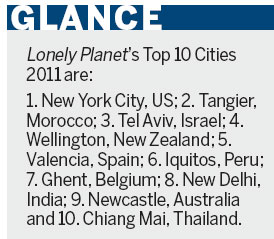Once dead Wellington bursts with life
By David Barber (China Daily)
Updated: 2010-11-18 09:20
 |
Large Medium Small |
Some years ago, an American tourist said cruelly but not, at the time, inaccurately, "Wellington is half the size of the New York City cemetery and twice as dead." Today, according to the Lonely Planet guidebook, it is "the Coolest Little Capital in the World".
Lonely Planet's Best in Travel 2011, published in November, ranked Wellington at No 4 in its list of the top 10 cities to visit in 2011, a remarkable accolade for a place that only a generation ago was one of the most maligned capitals, with a reputation for inclement weather and boring people and atmosphere.
The only capital city in the Roaring Forties, it continues to earn its sobriquet Windy Wellington as gale force winds frequently funnel through Cook Strait separating New Zealand's two main islands, strafing the city nestled on hills around a landlocked harbor.
"But despite (or maybe because of) its impetuous weather, Wellington is Cool-with-a-capital-C, crammed with more bars, cafes and restaurants per capita than New York, and a slew of gourmet producers including some 10 independent coffee roasteries," Lonely Planet writer Catherine Le Nevez writes in Best in Travel 2011.
Small - being home to under 480,000 of New Zealand's 4.4 million people and a third the size of the biggest city, Auckland - its compact size energizes its sense of community, Le Nevez writes. "Locals love their city and get a kick out of helping visitors fall in love with it too."
Up to the early 1980s, Wellington was "a gray, boring, bureaucratic city", in the words of former mayor Fran Wilde, who now chairs the Greater Wellington Regional Council.

The gray, boring bureaucrats went home to the suburbs at five o'clock and the city, its nightlife a closed-door secret to outsiders, died with the dusk. Tourists paused only to catch a ferry to cross Cook Strait.
A change of government in 1984 dismantled a century of regulations, paving the way for an explosion of bars and restaurants and 24-hour, seven-day-a-week opening. This coincided with extensive rebuilding of the central business district as the old, gray blocks of buildings were a prime risk in the earthquake-prone city on the Pacific's Ring of Fire.
Sensing a seminal mood change, a group of businessmen launched an "Absolutely Positively Wellington" campaign that the city council was quick to adopt and the slogan continues to decorate flagpoles, sweaters, posters, bumper stickers and shop windows.
Wellington justifiably calls itself New Zealand's culture capital, with a booming film industry (home to The Lord of the Rings studio), the national museum Te Papa, an abundance of art-house cinemas, theaters, an annual international film festival and a biennial arts festival.
But the scenic vistas, flora and fauna that New Zealand is renowned for are also close by.
The magnificent harbor is overlooked from a dramatic look-out atop 196-meter Mount Victoria or aboard a cable car that climbs from the city to the Botanic Garden, with its dramatic tulip displays in spring and 300 varieties of roses in summer.
A harbor ferry stops at the historic Matiu-Somes Island, alternatively a quarantine station for sick immigrants and animals, a detention center for Germans and Italians during World War II and now a conservation area for regenerating native trees and plants.
The flightless kiwi - the native bird and the national symbol - and the prehistoric tuatara lizard roam in a 225-hectare predator-proof sanctuary on the edge of the city, about 3,000 seals spend the winter on the volcanic Red Rocks and signs warn of penguins crossing coastal roads.
German Press Agency